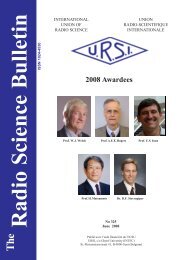Radio Science Bulletin 313 - June 2005 - URSI
Radio Science Bulletin 313 - June 2005 - URSI
Radio Science Bulletin 313 - June 2005 - URSI
- No tags were found...
You also want an ePaper? Increase the reach of your titles
YUMPU automatically turns print PDFs into web optimized ePapers that Google loves.
in the deployed configuration. This provides sufficientforce to fully open the reflector with the recommendedsafety factor [17]. At one point in the development we hadplanned to use a small servo motor to deploy the reflector;however, these motors are normally custom designed for aparticular application, so no adequate off-the-shelf motorwas found. An additional problem is that a small motorwould require a gear-type speed reducer with a very highmechanical advantage to provide the force required to holdthe reflector open. Springs seemed to be the best alternativefor the present design but since the antenna opens muchfaster than we would like, a motor drive may still berequired in the future. One problem with the motor drive isthat power is needed to drive the motor. This adds weightand/or complexity to the system. The Ti/Ni actuators can betriggered with a 9 V battery.The deployment mechanism has four stop pinassemblies that keep the cam from rotating and lock the camin the forward position after deployment. Since we decidedto use springs rather than a much more costly and complexmotor system, we were forced to include a damping system.This system uses an aluminum honeycomb material, whichis crushed to control the opening velocity of the cam and thesudden stop and consequent vibration at the end of thecam’s travel.One end of the stay adaptors or pivots that position thereflector ribs slides on the front surface of the cam as itmoves forward. This rotates the stay adaptors and movesthe stays to the open position. The surfaces of the movingaluminum parts are coated with Tufram® by GeneralMagnaplate. This coating creates a steel-hard, dry-lubricatedsurface on aluminum that reduces abrasion and corrosionand resists wear and galling. The dry-lubricated surfacesgreatly reduce the force required to overcome frictionbetween the various surfaces.A rear view of the deployment mechanism is shownin Figure 12. The actuator ERM is located in the center ofthe back plate and restrains the cam in the stowedFigure 13. UCIRA-2 in stowed, partially open, and fullydeployed configurations.configuration. There are four holes around the ERM forattaching the device that compresses the springs to put theUCIRA-2 in stowed configuration. Four rods thread intothe back side of the cam through these holes to pull the camback against the back plate while the coupler on the ERMis attached to hold the cam in place. The pin puller is locatedto the right and holds the end of a strap that restrains thereflector stays in the stowed configuration. Figure 12 alsoshows the two splitter/baluns (left and top) required for thedual polarity operation of the antenna.For proper deployment of the UCIRA we had todetermine the correct amount of crushable honeycombmaterial to use to retard the cam, which opens the reflector.We first tried a full circular section of the material and foundthat the cam was stopped immediately by the honeycomb.After several experiments we found that two sections of alittle over 1/8 circle each would allow the reflector to openfully. During these experiments the stay adapters weredamaged and had to be replaced. The original stay adapterswere made of aluminum and had a very thin cross sectionat the pivot point. The new stay adapters were made ofstainless steel and had a more substantial cross section at thepivot point. The ends of the stay adapters are highly polishedto reduce friction where they slide on the front of the cam.It was found during the deployment tests that thebending moment at the end of the stay adapters tends toover-stress the ends of the stays and several were brokenduring the tests. Longer stay adapters with deeper holes tosupport the ends of the stays would reduce this problem andimprove the shape of the reflector.Figure 12. UCIRA-2 deployment mechanism (rear).The UCIRA-2 was successfully deployed severaltimes while being video recorded digitally. Three stillpictures taken from the video showing the antenna in thestowed, partially open, and fully deployed states are shownin Figure 13. In the first picture the strap that holds the uppersection of the stays in the folded position is shown (white).The end of this strap is retained by the pin puller, which is44The<strong>Radio</strong> <strong>Science</strong> <strong>Bulletin</strong> No <strong>313</strong> (<strong>June</strong>, <strong>2005</strong>)
















